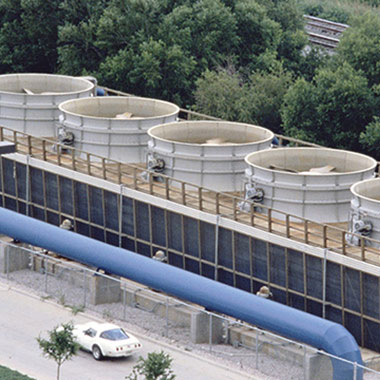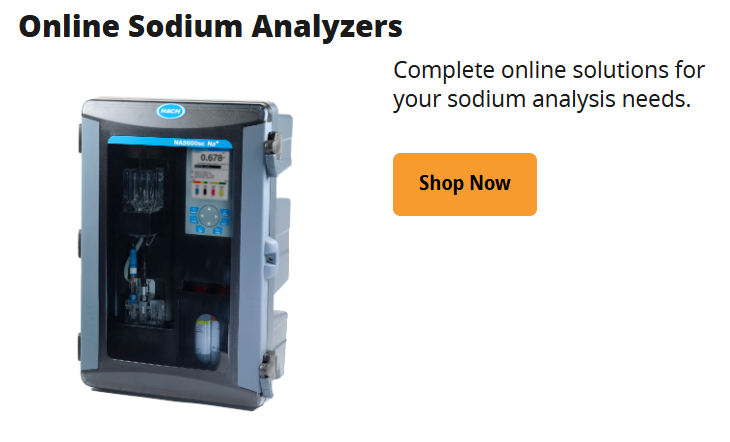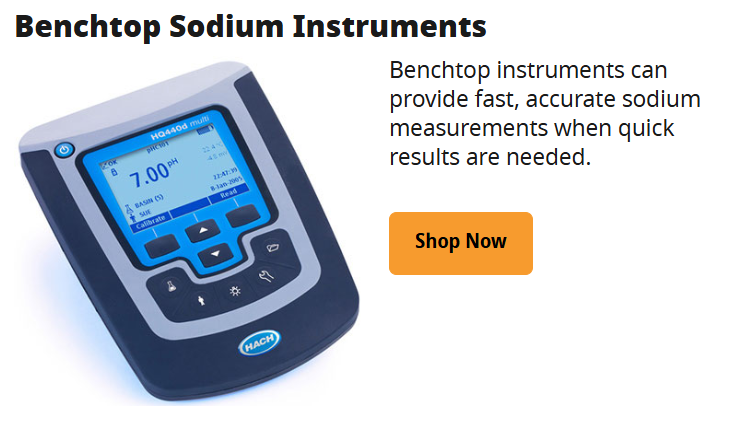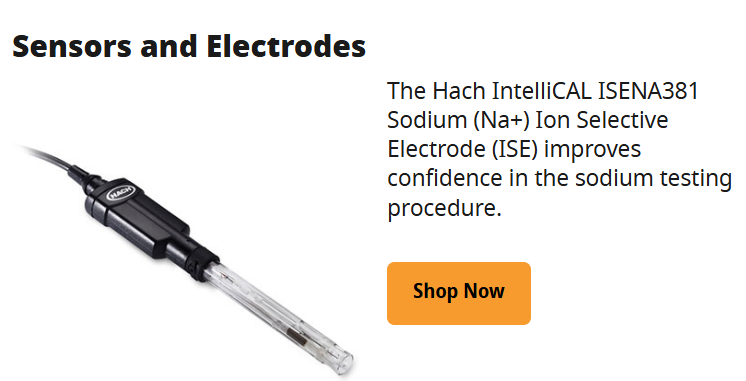水中鈉與分析 Sodium Analysis

Why Sodium Measurement, Testing and Analysis Matters to Water Quality 為什麼鈉濃度的測量分析對水質很重要?
Accurate sodium monitoring is crucial across a variety of industries, given its impact on water quality and process efficiency. Hach® offers tailored solutions with a comprehensive range of sensors, reagents, and analyzers, ensuring precise measurement and management of sodium levels. 由於鈉對水質和製程效率的影響,準確的水中鈉濃度監測對各產業都極為關鍵。 Hach 提供包含全系列感測器、試劑和分析儀的技術方案,確保水中鈉濃度的精確測量和管理。
Accurate sodium monitoring is crucial across a variety of industries, given its impact on water quality and process efficiency. Hach® offers tailored solutions with a comprehensive range of sensors, reagents, and analyzers, ensuring precise measurement and management of sodium levels. 由於鈉對水質和製程效率的影響,準確的水中鈉濃度監測對各產業都極為關鍵。 Hach 提供包含全系列感測器、試劑和分析儀的技術方案,確保水中鈉濃度的精確測量和管理。
Across both industrial and municipal applications, these sodium measurement solutions deliver the precision and reliability needed to prevent a variety of problems including 在工業和民生應用中,精確而可靠的水中鈉濃度測量方案可協助預防多種問題,包括 :
- In power plants and any steam-based industry, sodium can cause stress corrosion, which reduces efficiency, performance and equipment longevity. 對於發電廠和任何基於蒸汽應用的工業,鈉會引起應力腐蝕,進而降低效率、效能和設備壽命
- In groundwater, high concentrations may indicate pollution or saltwater intrusion. 地下水中高濃度的鈉可能表示受到污染或鹽水入侵
- In drinking water, excessive sodium levels can pose health risks for individuals with certain health conditions. 飲用水中鈉濃度過高可能會對患有某些健康狀況的人造成健康風險
Trust in Hach's solutions to provide the necessary tools for effective sodium monitoring and management. Hach 的產品技術方案能夠提供您有效的水中鈉濃度監測和管理所需的工具
Which Processes Require Sodium Monitoring? 哪些過程需要監測水中鈉濃度?
- Power Industry 電力產業
- Industrial Manufacturing 工業製造
- Ground Water 地下水
- Drinking Water 飲用水
- Pulp and Paper Industry 紙漿與造紙產業
- Metals and Mining 金屬與礦業
How is Sodium Monitored? 如何監測水中鈉濃度?
Direct Sodium ISE Method 直接鈉離子選擇電極法
The Sodium Ion Selective Electrode (ISE) is a sodium-sensing element that is bonded into an epoxy body. When the sensing element touches sodium ions in a solution, a potential develops across the sensing element. 鈉離子選擇電極 (ISE) 是一種黏合在環氧樹脂體內的鈉感測元件。當感測元件接觸溶液中的鈉離子時,感測元件上就會產生電位。
The Sodium Ion Selective Electrode (ISE) is a sodium-sensing element that is bonded into an epoxy body. When the sensing element touches sodium ions in a solution, a potential develops across the sensing element. 鈉離子選擇電極 (ISE) 是一種黏合在環氧樹脂體內的鈉感測元件。當感測元件接觸溶液中的鈉離子時,感測元件上就會產生電位。
The potential is proportional to the level of sodium ions in the sample. The potential is measured against a constant reference potential with a pH/mV meter or ISE meter. 此電位與水樣中的鈉離子含量成正比。使用 pH/mV 計或 ISE 計根據恆定參考電位測量電位。
Intellical™ ISENa381 is a digital, combination, sodium ion selective electrode (ISE) with a refillable double junction reference and built-in temperature sensor. The electrode measures sodium concentration in water samples. A 59 mL bottle of 0.02 M NH4Cl Electrode Filling Solution is included with the probe. Intellical™ ISENa381 是一款數位複合型鈉離子選擇電極 (ISE),具有可再填充雙結參考和內建溫度感測器。電極測量水樣中的鈉濃度。探頭附帶一瓶 59 毫升 0.02 M NH4Cl 電極填充液。
The laboratory version of this ISE is shockproof with its Zeonor plastic body. The Intellical ISENa381 probe is available with a 1 or 3 meter cable and is intended for laboratory use. The ISENa381 is ideal for measuring sodium concentrations in wastewater, drinking water and general water quality applications. 這款 ISE 的實驗室版本採用 Zeonor 塑膠材質,並具有防震功能。 Intellical ISENa381 探頭配備 1 公尺或 3 公尺長電纜線,適合實驗室使用。 ISENa381 非常適合測量廢污水、飲用水和一般水質應用中的鈉濃度。
Online or Process Analysis 線上或過程分析
NA9600sc Sodium Analyzer uses an ion-selective electrode measurement after pH conditioning. Sample pH conditioning is essential for limiting the interference of temperature or other ions on sodium measurement. NA9600sc 鈉線上分析儀以 pH 調節後的離子選擇電極進行測量。水樣 pH 值調節對於限制溫度或其他離子對鈉測量的干擾很重要。
NA9600sc Sodium Analyzer uses an ion-selective electrode measurement after pH conditioning. Sample pH conditioning is essential for limiting the interference of temperature or other ions on sodium measurement. NA9600sc 鈉線上分析儀以 pH 調節後的離子選擇電極進行測量。水樣 pH 值調節對於限制溫度或其他離子對鈉測量的干擾很重要。
Constant, temperature-compensated buffering is assured using regulated reagent addition across sample pH and temperature changes. In case of a multi-channel version, the “smart” rinsing sequence between channels ensures a minimum cycle time of 10 minutes and no carry-over effect. 透過調節試劑的投放量來控制水樣 pH 值和溫度的變化,進而確保恆定的溫度補償緩衝。關於多通道的機款,通道之間的「智慧型」清洗序列可確保最短循環時間為 10 分鐘,並且不會產生殘留效應。
Ranges 量測範圍 :
- Analyzers without cationic pump 不含陽離子幫浦的鈉離子線上分析儀 : 0.01 ppb - 10,000 ppb
- Analyzers with cationic pump 陽離子幫浦的鈉離子線上分析儀 : 0.01 ppb - 200 ppm
Power Industry 電力產業
Steam 蒸汽

Presence of sodium in concentration as low as micrograms or even nanograms per liter in steam before the superheater, may cause its stress corrosion.
Under the conditions of high pressure and temperature of today’s power plant, the problem of steam solubility of inorganic compounds is increasingly important.
Of significance is the steam solubility (in addition to carry-over) of sodium compounds, e.g. sodium chloride (NaCl) and sodium hydroxide (NaOH), because of the possibility of stress corrosion cracking in the superheating section. The measurement of sodium directly in steam immediately before entering the superheater is now recognized as a strong indicator of possible stress corrosion in the superheater.
It should be noted that corrosion will occur only if sodium is present with chlorides or hydroxide anions and not, for instance, with sulfates. Chlorides and hydroxides are corrosive, but not the sodium. The latter serves only as the carrier, specifically. Specifically, for plants with low boiler pressure (40-80 bars). Since non-volatile boiler treatments are typically sodium based (i.e. a mixture of sodium phosphate tribasic and sodium phosphate di-basic), the measurement of sodium in the steam is an excellent indication of mechanical carryover from the drum into the steam.
Condensate 冷凝水
Sodium measurement should be the preferred option for early warnings of excursions on condensates to minimize associated risks.
Sodium measurement should be the preferred option for early warnings of excursions on condensates to minimize associated risks.
Condensate polishing plays a vital role in power plant cycle chemistry, providing the means to reduce the transport of metal oxide and ionic impurities to the steam generator during all modes of operation, mostly during start-up and upset conditions. The benefits of condensate polishing are:
- Reduced delays to commissioning and start-up as a result of chemistry transients
- Protection of the steam generator during impurity ingress, such as with condenser in-leakage
- Reduced impurities fed to steam generators, thereby minimizing the frequency of chemical cleaning
- Improved steam purity resulting in less turbine deposition and phase transition zone corrosion
- Virtual elimination of chemically influenced boiler tube failures
- Attainment of the high degree of feedwater purity necessary for chemical programs, such as oxygenated treatment for drum and once-through boilers
Careful management of condensate polishing systems is essential; otherwise polishing plants can become a source of ongoing feed system pollution.
Extracting the maximum benefit from condensate polishing systems continues to be a top priority among many electric utility plants.
Although cation and specific conductivity are used frequently to detect excursions in the water/steam loop, it is no longer sufficiently sensitive to measure the very small condenser leaks which have assumed greater importance in modern plant designs. In everyday conditions (with possible temperature, pressure and flow upset or high conductivity background levels), the minimum meaningful variation will be 0.02 mS/cm. This corresponds to 11 ppb sodium.
Sodium analysis is much more sensitive. A Hach NA9600 sodium analyzer can accurately measure below 0.1 ppb. This is 100 times more sensitive than a conductivity measurement. Just as water quality is critical, early signs of excursions are also critical. Sodium measurement should be the preferred option to minimize risk.
Steam purity can be more accurately assessed by measuring sodium concentration in both steam and condensate, thus determining the “sodium balance.” The two concentrations should be equal. A higher level of sodium in the condensate indicates a condenser leakage. A lower level of sodium in the condensate indicates deposition of sodium in the steam circuit (on heat transfer surfaces, on turbine blades, etc.).
Sodium measurement is the only online technique that achieves accurate and rapid response at any time to detect traces of hydroxides and chlorides known to be contributory factors in the stress-corrosion of austenitic steel.
The origin of the de-superheating water is the condensate water. The quality of the de-superheating water must be without any doubt. If it is contaminated, this contamination will be brought directly into the de-superheated steam. The section most likely to be affected is the section of the superheater immediately following the point at which the de-superheater spray water is injected. It is made of austenitic steel for its mechanical behavior (low thermal dilatation coefficient), but it is more sensitive to corrosion (increased percentage of iron versus carbon). To avoid the catastrophic effect of impurities in the de-superheating water, any excursion must be detected as quickly as possible.
Online sodium measurement is the only technique that achieves accurate detection of excursions. A Hach NA9600sc sodium analyzer will ensure a rapid response at any time through regular reactivation of the electrode.
Demineralization Plant
For a demineralization plant, online sodium measurement is all about ion exchange resin management. (Learn more about hardness). Customer benefits are:
For a demineralization plant, online sodium measurement is all about ion exchange resin management. (Learn more about hardness). Customer benefits are:
- Better utilization of the resin capacity
- Minimize sodium breakthroughs
- Optimize acid rinse-out
- Optimization of regeneration cycles
Cation resin bed exhaustion and its regeneration timing can be monitored with high sensitivity and reliability using online sodium analyzers. Cation resins remove cations such as sodium (Na+). Sodium is the first cation that breaks through when the cation resin bed is exhausted.
Measuring sodium immediately after cation resins gives an early warning of breakthrough. Removing the saturated resin bed and replacing it with a new (regenerated) one protects the ion exchange capacity of the mixed-bed resins installed farther down the stream.
Quality of the incoming water, the resin quality itself, and temperature modifies the ion exchange capacity of the cationic resin bed. This influences the time before the next regeneration. When this time is indicated by a simple volume of sample running through the resin, it is an estimate that may lead to saturation and breakthrough or underuse of resin capacity. Online measurement of sodium allows regeneration of the cation resin as required.
After mixed bed resins, online sodium analysis ensures the quality validation of the demineralized water delivered to the make-up plant. Mixed bed resin contains a mixture of both cation and anion exchange resins for a fine polish of the pure water. It reduces any contaminant left in the pure water.
Remarkable progress has been made over the past decade to reduce the levels of contaminant ions in the treated water from mixed beds. Specifically, in nuclear plants (PWR), mixed beds treated water purity is reported in steady state values at 25 to 35 ppt for sodium. Here, sodium analyzers are used to monitor the final water quality, acting as a final check of quality. Hach NA5600 sodium analyzers are used to check the quality of the final water down to 20 ppt levels.
Additionally, a malfunction of the regeneration cycle of the mixed bed resin is detected by sodium monitoring. Release of sodium can happen by accidental caustic release when there is insufficient rinsing of the mixed bed anion resin. Again, the warning comes earlier and with higher precision with a sodium analyzer than by conductivity.
Sodium levels lower than 1 ppb are commonly found at the mixed bed output, both in the steam circuit and in the condensate. Levels of 0 - 10 ppb can be found under normal working conditions at the cation exchangers output, but this can become as high as 100 ppb at the resin exhaustion or in boiler water.
Industrial Manufacturing 工業製造

The condensates from combined steam and cogeneration boilers in heavy industry (chemical and petrochemical, pulp and paper, metal, etc.) can represent a large saving due to the high quality of the steam condensates used in the high-pressure boilers. As the steam and/or the condensates are often used to transfer heat to the process, their recovery is subject to their level of quality. Any degradation of their quality is a sign of ingress of the process fluids into the condensate and consequently requires maintenance on the circuits.
In processes where caustic soda or concentrated sodium salt solutions are likely to be present in contact with the steam and/or condensates, the analysis of sodium represents an alternative to the usual measurement of conductivity with a higher sensitivity for an early detection.
Conductivity of high-pressure condensates are usually better than 1 μS and limits set for 5 to 10 μS to decide the recovery or not, in order to avoid early exhaustion of the polishing demi-resins. Such conductivity corresponds to the presence of about 2 to 5 ppm (parts per million) of sodium salt.
The actual quality of the standard ion-exchange resins used in demineralization plants in most power or cogeneration plants, produce water with sodium concentrations lower than 10 ppb (parts per billion) in normal conditions. A raise from 1 to 10 ppb is already significant and a raise from 10 to 100 ppb shows without any doubt a major problem requiring immediate intervention.
Sodium analyzers have been operating with full satisfaction and little maintenance over the past decade in most power plants with low ppb and even ppt concentration levels in nuclear plants.
Conductivity measurement can reliably detect 2 to 5 ppm of sodium, while sodium measurement detects 2 to 5 ppb. That's 1000 times lower. This sensitivity allows chemists to follow trend changes before any leakage requires major immediate action. This sensitivity advantage can be converted over time to analyze the origin of the leakage and to plan either a production reduction, or even to stop production far enough in advance to avoid costly, emergency shutdowns.
Ground Water 地下水
All groundwater contains some sodium due to rocks and soils containing sodium compounds. However, elevated sodium levels may indicate contamination that requires treatment:
All groundwater contains some sodium due to rocks and soils containing sodium compounds. However, elevated sodium levels may indicate contamination that requires treatment:
- Erosion of salt deposits
- Water intrusion in wells (in coastal areas)
- Surface water contamination from road salt
- Irrigation and precipitation leaching through soils high in sodium
- Pollution by sewage effluent
- Infiltration of leachate from landfills or industrial sites
Pulp and Paper Industry 紙漿和造紙產業
Sodium sulfite or bisulfite can be used as an oxygen scavenger agent to treat water being fed to steam boilers, in order to prevent corrosion. In this case, monitoring sodium will help in optimizing the process and provide chemical cost savings.
Sodium sulfite or bisulfite can be used as an oxygen scavenger agent to treat water being fed to steam boilers, in order to prevent corrosion. In this case, monitoring sodium will help in optimizing the process and provide chemical cost savings.



